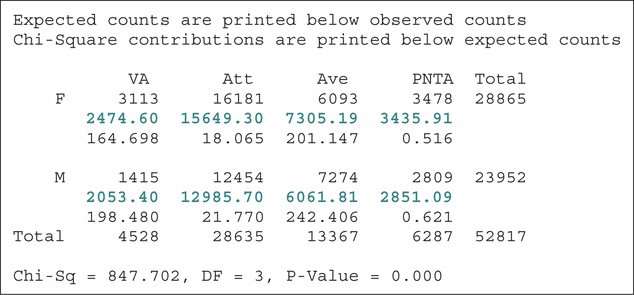11.2 χ2 Tests for Independence and for Homogeneity of Proportions
OBJECTIVES By the end of this section, I will be able to …
- Explain what a χ2 test for the independence of two variables is.
- Perform and interpret a χ2 test for the independence of two variables using the critical-value method and the p-value method.
- Perform and interpret a test for the homogeneity of proportions.
1 Introduction to the χ2 Test for Independence
In Section 11.1, we learned that the χ2 distribution could help us determine a model's goodness of fit to the data. Here, in Section 11.2, we will learn two more hypothesis tests that use the χ2 distribution. Recall from Section 2.1 that a contingency table, also known as a crosstabulation or a two-way table, is a tabular summary of the relationship between two categorical variables. The categories of one variable label the rows, and the categories of the other variable label the columns. Each cell in the table contains the number of observations that fit the categories of that row and column. Table 7 is a contingency table based on the study How Young People View Their Lives, Futures, and Politics: A Portrait of “Generation Next.”5 The researchers asked 1500 randomly selected respondents, “How are things in your life?” Subjects were categorized by age and response. The researchers identified those ages 18–25 as representing “Generation Next.”
The term contingency table derives from the fact that the table covers all possible combinations of the values for the two variables, that is, all possible contingencies.
| Age group | ||||
|---|---|---|---|---|
| Response | Gen Nexter (18–25) |
26+ | Total | Relative frequency |
| Very happy | 180 | 330 | 510 | 5101500=0.34 |
| Pretty happy | 378 | 435 | 813 | 8131500=0.542 |
| Not too happy | 42 | 135 | 177 | 1771500=0.118 |
| Total | 600 | 900 | 1500 | |
| Relative frequency | 6001500=0.4 | 9001500=0.6 | ||
We can use contingency tables like Table 7 to determine whether two random variables are independent. Recall that two random variables are independent if the value of one variable does not affect the probabilities of the values of the other variable. For example, is a “Gen Nexter” (someone age 18–25) less likely to report that he or she is “very happy” and more likely to report that he or she is “pretty happy” than someone older? If so, then the response depends on age, so the variables age group and response are dependent.
By “dependent” we simply mean that the variables are not independent.
To determine whether two categorical variables are independent, using the data in a contingency table, we use a χ2 test for independence. Just like our χ2 goodness of fit test from Section 11.1, the χ2 test for independence is based on a comparison of the observed frequencies with the frequencies that are expected if the null hypothesis is assumed true.
χ2 Test for Independence
To determine whether two categorical variables are independent, using the data from a contingency table, we use a χ2 test for independence. The hypotheses take the form
- H0:Variable A and Variable B are independent.
- Ha:Variable A and Variable B are dependent.
We compare the observed frequencies with the frequencies that we expect if we assume that H0 is correct. Large differences lead to the rejection of the null hypothesis.
Here, we are testing whether the variables age group and response are independent. Thus, the hypotheses are
- H0:Variable Age group and response are independent.
- Ha:Variable Age group and response are dependent..
H0 states that a response to the survey question does not depend on the age group.
Ha says that a response does depend on the age group. To calculate the expected frequencies, we begin by recalling the Multiplication Rule for Two Independent Events from Chapter 5 (page 277):
If A and B are any two independent events, P(A and B)=P(A)P(B).
To illustrate, let our events be defined as A=age 18–25 group, and B=reported “very happy.“ Then, on the assumption that these events are independent, we have
P(Gen Nexter and very happy)=P(A and B)=P(A)P(B)=6001500⋅5101500=0.4⋅0.34=0.136
Thus, the probability that a randomly chosen young person is both a Gen Nexter and is very happy is 0.136. Then, to find the expected frequency of this cell (Gen Nexters who are very happy), we multiply this probability 0.136 by the total sample size n=1500, using the result from Section 11.1 that the expected frequency is
E=expected frequency=n·p=1500·0.136=204
In other words, if the random variables age group and response are independent, then the expected frequency of Gen Nexters who report being very happy is
expected frequencyGen Nexter and very happy=1500·6001500·5101500=204
But note that two of the 1500s cancel, providing us with the shortcut
expected frequencyGen Nexter and very happy=(600)(510)1500=204
Generalizing, this provides us with the following shortcut method for finding expected frequencies.
Expected Frequencies for a χ2 Test for Independence
The expected frequencies for the cells of a contingency table in a χ2 test for independence are given by
expected frequency=(row total)(column total)grand total
EXAMPLE 6 Calculating expected frequencies using the shortcut method
Calculate the expected frequencies from Table 7 using the shortcut method.
Solution
Table 8 contains the expected frequencies calculated using the shortcut method.
| Age group | |||
|---|---|---|---|
| Response | Gen Nexter (18–25) | 26+ | Total |
| Very happy | (510)(600)1500=204 | (510)(900)1500=306 | 510 |
| Pretty happy | (813)(600)1500=325.2 | (813)(900)1500=487.8 | 813 |
| Not too happy | (177)(600)1500=70.8 | (177)(900)1500=106.2 | 177 |
| Total | 600 | 900 | 1500 |
NOW YOU CAN DO
Exercises 5–10.
The χ2 test for independence measures the difference between the observed frequencies and the expected frequencies, using the following test statistic.
Test Statistic for the χ2 Test for Independence
Let Oi represent the observed frequency in the ith cell, and Ei represent the expected frequency in the ith cell. Then the test statistic for the independence of two categorical variables
χ2data=∑(Oi-Ei)2Ei
approximately follows a χ2 distribution with (r-1)(c-1) degrees of freedom, where r is the number of categories in the row variable and c is the number of categories in the column variable, if the following conditions are satisfied:
- None of the expected frequencies is less than 1.
- At most, 20% of the expected frequencies are less than 5.
2 Performing the χ2 Test for Independence
The χ2 test for independence may be performed using either the critical-value method or the p-value method. We provide examples of each.
χ2 Test for Independence: Critical-Value Method
- Step 1 State the hypotheses and check the conditions.
- H0:Variable A and Variable B are independent.
- Ha:Variable A and Variable B are dependent..
The following conditions must be met:
- None of the expected frequencies is less than 1.
- At most, 20% of the expected frequencies are less than 5.
The expected frequency for a given cell is
expected frequency=(row total)·(column total)grand total
- Step 2 Find the critical value χ2crit and state the rejection rule. Reject H0 if χ2data≥χ2crit. Use (r-1)(c-1) degrees of freedom, where r is the number of categories in the row variable and c is the number of categories in the column variable.
Step 3 Calculate χ2data.
χ2data=∑(Oi-Ei)2Ei
where Oi=observed frequency and Ei=expected frequency for each cell.
- Step 4 State the conclusion and the interpretation. Compare χ2data with χ2crit.
 Do not include the row or column totals when counting the categories.
Do not include the row or column totals when counting the categories.
EXAMPLE 7 Performing the χ2 test for independence using the critical-value method
Using Table 7, test whether age group is independent of response, using level of significance α=0.05.
Solution
Step 1 State the hypotheses and check the conditions.
- H0:Variable Age group and response are independent.
- Ha:Variable Age group and response are dependent.
We note from Table 8 that none of the expected frequencies are less than either 1 or 5. Therefore, the conditions are met, and we may proceed with the hypothesis test.
See Figure 1 (page 638) to review how to find χ2crit.
Step 2 Find the critical value χ2crit and state the rejection rule. The row variable, response, has three categories, so r=3. The column variable, age group, has two categories, so c=2 Thus,
degrees of freedom=(r-1)(c-1)=(3-1)(2-1)=2
With level of significance α=0.05, this gives us χ2crit=5.991 from the χ2 table. The rejection rule is therefore
Reject H0 if χ2data≥5.991
Step 3 Calculate χ2data. The observed frequencies are found in Table 7 and the expected frequencies are found in Table 8. Then
χ2data=∑(Oi−Ei)2Ei=(180−204)2204+(330−306)2306+(378−325.2)2325.2+(435−487.8)2487.8+(42−70.8)270.8+(135−106.2)2106.2≈38.5192
- Step 4 State the conclusion and the interpretation. Our χ2data of 38.5192 is greater than our χ2crit of 5.991 (see Figure 16), and so we reject H0. The interpretation is: “There is evidence at level of significance α=0.05 that age group and response are dependent.”Page 650FIGURE 16 χ2data=38.5192 lies in the critical region.
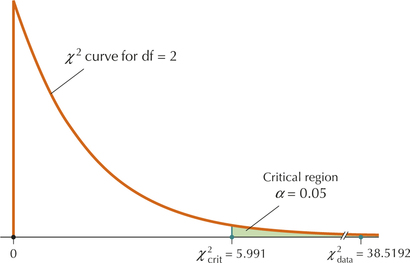
NOW YOU CAN DO
Exercises 11–14.
χ2 Test for Independence: p-Value Method
- Step 1 State the hypotheses and the rejection rule. Check the conditions.
- H0:Variable A and Variable B are independent.
- Ha:Variable A and Variable B are dependent..
Reject H0 if the p-value ≤α.
The following conditions must be met:
- None of the expected frequencies is less than 1.
- At most, 20% of the expected frequencies are less than 5.
The expected frequency for a given cell is
expected frequency=(row total)(column total)grand total
Step 2 Calculate χ2data.
χ2data=∑(Oi-Ei)2Ei
where Oi=observed frequency and Ei=expected frequency for each cell.
Step 3 Find the p-value.
p-value=P(χ2>χ2data)
- Step 4 State the conclusion and the interpretation. Compare the p-value with α.
EXAMPLE 8 χ2 test for independence using the p-value method and technology
youngliving
The National Center for Health Statistics publishes information on the living arrangements of America's young people. Table 9 contains a random sample of 200 young people ages 1-24, indicating their gender and living arrangements. Test whether gender and living arrangement are independent, using the TI-83/84, Minitab, JMP, the p-value method, and level of significance α=0.10.
| Living arrangements | ||||
|---|---|---|---|---|
| Gender | Living with parents |
Living with partner |
All other arrangements |
Total |
| Female | 51 | 22 | 28 | 101 |
| Male | 58 | 14 | 27 | 99 |
| Total | 109 | 36 | 55 | 200 |
Solution
Step 1 State the hypotheses and the rejection rule. Check the conditions.
- H0: Gender and living arrangements are independent.
- Ha: Gender and living arrangements are dependent.
Reject H0 if the p-value ≤0.10.
Note that Minitab provides the expected counts (frequencies) below the observed counts. We can then verify that none of the expected frequencies is less than 1, and that none of the expected frequencies has a value less than 5.
Step 2 Calculate χ2data. We use the instructions found in the Step-by-Step Technology Guide at the end of this section. The TI-83/84 results in Figure 17 tell us that χ2data=2.225723453. The Minitab results in Figure 18 round this to “Pearson Chi-Square”=χ2data=2.226 The JMP results in Figure 19 (“Pearson”) also round this to “ChiSquare”=χ2data=2.226.
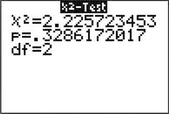 FIGURE 17 TI-83/84 χ2 results.
FIGURE 17 TI-83/84 χ2 results.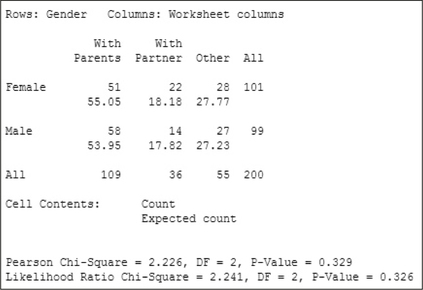 FIGURE 18 Minitab χ2 results.
FIGURE 18 Minitab χ2 results.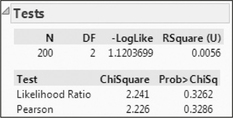 FIGURE 19 JMP χ2 results.
FIGURE 19 JMP χ2 results.Step 3 Find the p-value. From the TI-83/84 results in Figure 17, we have
p-value=P(χ2>χ2data)=0.3286172017≈0.329.
- Step 4 State the conclusion and the interpretation. Because p-value ≈ 0.329 is not less than level of significance 0.10, we do not reject H0. There is insufficient evidence that gender and living arrangements are dependent.
NOW YOU CAN DO
Exercises 15–18.
3 χ2 Test for the Homogeneity of Proportions
Recall the two-sample Z test for p1−p2 from Section 10.3, where we compared the proportions of two independent populations. When we extend that hypothesis test to k independent populations, we use a test statistic that follows a χ2 distribution. Just as the null hypothesis for the two-sample test assumed no difference between the population proportions
- the null hypothesis for the k-sample test also assumes that all k proportions are equal, and
- the alternative hypothesis states that not all the population proportions are equal.
When performing the test for the homogeneity of proportions, we use the same steps as for the χ2 test for independence.
Developing Your Statistical Sense
Difference Between χ2 Test for Homogeneity and χ2 Test for Independence
The difference between the test for homogeneity of proportions and the test for independence has to do with how the data are collected. If a single sample is taken and two variables are measured, then the test for independence is appropriate.
If several (k) samples are taken and the sample proportion is measured for each sample, then the test for homogeneity of proportions is appropriate.
EXAMPLE 9 χ2 Test for the homogeneity of proportions

The American Academy of Pediatrics recommends that children's TV-watching time be limited to two hours or less per day. Here, we examine whether a relationship exists between watching TV for more than two hours per day and being overweight. The National Center for Health Statistics conducted a survey of children 12–15 years old. Three random samples were taken, one sample of normal or underweight children, one sample of overweight children, and one sample of obese children. The surveys noted whether the children watched TV more than two hours per day. The results are shown in Table 10.
Test whether the population proportions of children watching more than two hours per day of TV are the same for the three weight statuses, using the p-value method, Minitab, and level of significance α=0.05.
tvandweight
| Normal or underweight |
Overweight | Obese | Total | |
|---|---|---|---|---|
| Number watching more than two hours of TV |
140 | 44 | 82 | 266 |
| Number watching two hours or less of TV |
329 | 80 | 91 | 500 |
| Total | 469 | 124 | 173 | 766 |
Solution
The Minitab results are shown here in Figure 20.
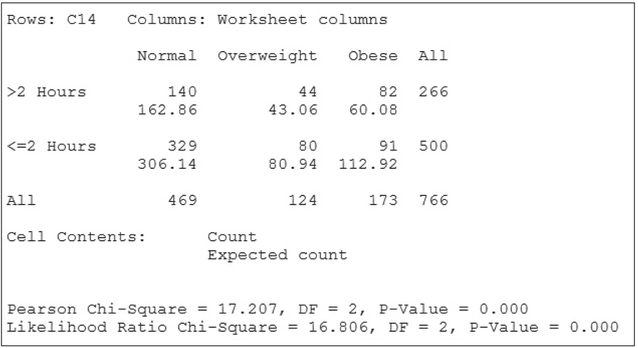
We use the same steps as for the χ2 test for independence.
Step 1 State the hypotheses and the rejection rule. Check the conditions.
- H0:pNormal/Under=pOverweight=pObese
- Ha: Not all the proportions in H0 are equal.
Reject H0 if the p-value ≤0.05.
The expected frequencies are shown in Figure 20. None of them are less than either 1 or 5. Therefore, the conditions are met, and we may proceed with the hypothesis test.
Note: The conditions and the test statistic for the test for the homogeneity of proportions are the same as for the test for independence.
- Step 2 Find the test statistic χ2data•χ2data is shown as “Pearson Chi-Square = 17.207.” There are r=2 rows and c=3 columns, so the degrees of freedom are (r-1)(c-1)=(2-1)(3-1)=2.
- Step 3 Find the p-value. Minitab provides the p-value, which is essentially 0.000.
- Step 4 State the conclusion and the interpretation. The p-value of 0.000 is less than α=0.05. We therefore reject H0. Evidence exists, at level of significance α=0.05, that not all population proportions of watching TV more than two hours per day are equal.
NOW YOU CAN DO
Exercises 19–26.

 Online Dating
Online Dating
We look at two tests for independence in this Case Study. The first examines whether the type of relationship reported by respondents depends on the gender of the respondent. The second investigates whether the self-reported physical appearance of online daters depends on the person's gender.
Does the reported Type of relationship Depend on Gender?
The Pew Internet and American Life Project examined whether single men and women differed with respect to their current relationships. The observed frequencies are given in Table 11.
onlinedating
| Gender | ||
|---|---|---|
| Type of relationship | Single men | Single women |
| In committed relationship | 115 | 138 |
| Not in committed relationship and not looking for partner |
162 | 391 |
| Not in committed relationship but looking for partner |
89 | 54 |
| Don't know/refused | 19 | 18 |
We are interested in whether the type of relationship reported depends on the gender of the respondent. In other words, we will test whether the type of relationship is independent of gender. We will use the p-value method, with level of significance α=0.05, and we will follow the TI-83/84 instructions in the Step-by-Step Technology Guide on page 656 for the calculations.
What Results Might We Expect?
Table 11 and Figure 21 indicate that the proportion of men who are “looking” is greater than the proportion of women who are “looking.” Similarly, the proportion of women who are “not looking” is greater than for men. This is evidence that the type of relationship depends on gender and that we might expect to reject the null hypothesis of independence.
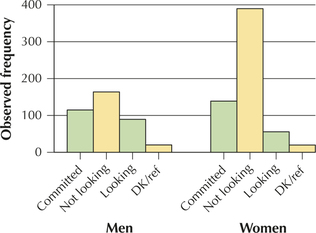
Step 1 State the hypotheses and the rejection rule. Check the conditions.
- H0:Type of relationship and gender are independent.
- Ha:Type of relationship and gender are dependent.
Reject H0 if the p-value ≤0.05.
Figure 22 shows the expected frequencies, none of which are less than 5. Thus, the conditions are met.
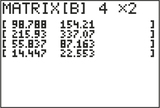 FIGURE 22 Expected frequencies.
FIGURE 22 Expected frequencies.Step 2 Find χ2data• The TI-83/84 results in Figure 23 tell us
χ2data=61.12955651
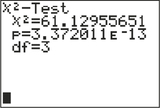 FIGURE 23 χ2 results on TI-83/84.
FIGURE 23 χ2 results on TI-83/84.Step 3 Find the p-value. Figure 23 also gives us the p-value:
p-value=3.372011E-13≈0.0000000000003372011
- Step 4 State the conclusion and the interpretation. The p-value ≤α=0.05, so we reject H0, as we expected. There is evidence that the type of relationship reported in the study depends on the gender of the respondent for level of significance α=0.05.

Does Self-Reported Physical Appearance of Online Daters Depend on Gender?
onlineappear
A Master's thesis from the Massachusetts Institute of Technology examined the charonlineappear acteristics and behavior of online daters.6 Table 12 contains the self-reported physical appearance and gender of 52,817 users of an online dating service.
| Physical appearance | |||||
|---|---|---|---|---|---|
| Very attractive |
Attractive | Average | Prefer not to answer |
Total | |
| Female | 3,113 | 16,181 | 6,093 | 3,478 | 28,865 |
| Male | 1,415 | 12,454 | 7,274 | 2,809 | 23,952 |
| Total | 4,528 | 28,635 | 13,367 | 6,287 | 52,817 |
Note from Table 12 that females seem to have higher proportions of those self-reporting as either attractive or very attractive, whereas males seem to have a higher proportion of those self-reporting as average. This is evidence that self-reported physical appearance does depend on gender and that we might expect to reject the null hypothesis of independence. We will test with the p-value method, using level of significance α=0.01, and Minitab. The hypotheses are
- H0:Self-reported physical appearance and gender are independent.
- Ha:Self-reported physical appearance and gender are dependent.
We reject H0 if the p-value ≤ level of significance α=0.01.
The Minitab results in Figure 24 tell us
χ2data="
Figure 24 gives us the expected frequencies (highlighted in color), none of which are less than 5, allowing us to perform the hypothesis test. The p-value , so we reject , as we expected. There is evidence at level of significance that the self-reported physical appearance depends on the gender of the online dater.
